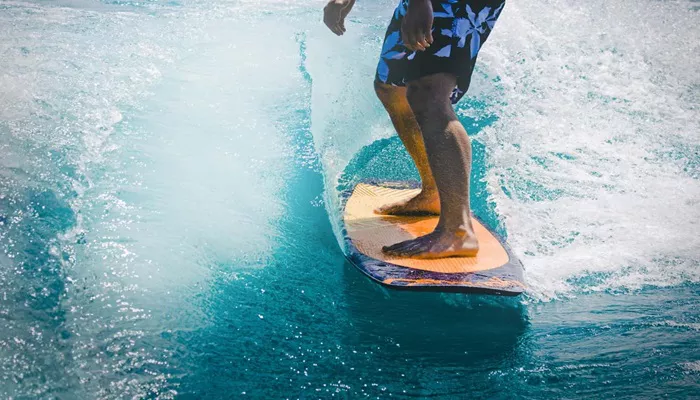Wake surfing is an exhilarating water sport that blends elements of traditional surfing and wakeboarding. Unlike wakeboarding, wake surfing is done without being directly towed by a rope. Instead, the surfer rides the wake created by a boat, using its energy to surf continuously. However, one of the most challenging aspects for beginners is learning how to stand up properly. This guide will walk you through the techniques, tips, and step-by-step instructions to help you master standing up on a wake surfboard with ease.
Understanding the Basics of Wake Surfing
Before learning to stand up, it is essential to understand some fundamental concepts of wake surfing:
1. Equipment Needed
Wake Surfboard – Choose a board that suits your riding style (skim-style or surf-style).
Tow Rope – A short, thick, and easy-to-grip rope.
Boat with Ballast System – A wake-specific boat that creates a consistent, surfable wake.
Life Jacket – A properly fitted U.S. Coast Guard-approved life jacket for safety.
2. Positioning the Boat for Wake Surfing
The boat should be moving at a speed between 9-12 mph (14-19 km/h), with the ballast system adjusted to create a clean wake on one side. The left side is for regular stance surfers, and the right side is for goofy stance surfers.
3. Stance and Foot Positioning
Before getting into the water, determine your stance:
Regular Stance – Left foot forward.
Goofy Stance – Right foot forward.
Step-by-Step Guide to Standing Up Wake Surfing
Now that you have a basic understanding, let’s go through the steps to stand up successfully.
1. Starting Position in the Water
Sit in the water with your wake surfboard floating in front of you.
Keep your heels resting on the board’s edge, with your knees bent.
Hold the rope with both hands in a relaxed grip.
2. Let the Boat Do the Work
Signal the boat driver when you are ready.
As the boat starts moving slowly, let the board press against the soles of your feet.
Keep your arms extended but relaxed, allowing the boat to gradually pull you forward.
3. Rolling Up Onto the Board
As the boat picks up speed, resist the urge to pull yourself up with your arms.
Let your feet stay firmly planted as the board begins to rise beneath you.
Once the board is almost perpendicular to the water, start shifting into a squat position.
4. Popping Up into a Standing Position
When you feel stable, push up gently with your legs while keeping your knees slightly bent.
Shift your weight slightly onto your back foot to prevent nose-diving.
Keep your chest up and look forward to maintain balance.
5. Adjusting Your Stance for Stability
Position your front foot near the middle of the board and your back foot closer to the tail.
Keep your knees bent and your weight evenly distributed.
Engage your core for better stability.
Common Mistakes And How to Avoid Them
1. Pulling on the Rope Too Hard
Beginners often try to pull themselves up using their arms. Instead, let the boat do the work and focus on balance.
2. Standing Up Too Quickly
Rushing to stand can cause loss of balance. Take your time and gradually rise into a stable position.
3. Leaning Too Far Forward
This can result in the nose of the board digging into the water, causing you to fall. Keep your weight centered or slightly back.
4. Not Keeping Knees Bent
Straight legs make balancing difficult. A slight bend in the knees absorbs movement and helps maintain control.
Tips for Improving Your Stand-Up Technique
1. Practice on Land First
Before getting into the water, practice the stand-up motion on dry land to develop muscle memory.
2. Use a Shorter Rope at the Start
A shorter rope keeps you closer to the wake, making it easier to maintain balance as you stand up.
3. Engage Your Core Muscles
A strong core helps maintain stability and control while transitioning from a seated to a standing position.
4. Focus on Your Body Position
Keep your chest up, back straight, and eyes looking ahead instead of down at your feet.
Progressing Beyond Standing Up
Once you master standing up, you can start refining your wake surfing skills:
1. Learning to Let Go of the Rope
Once you can maintain balance, start shifting weight slightly forward and use the wake’s energy to stay in motion without relying on the rope.
2. Carving and Turning
Use subtle toe and heel movements to carve across the wake and generate speed.
3. Practicing Tricks
As you become comfortable, experiment with tricks like 360 spins and floaters to advance your wake surfing experience.
Conclusion
Standing up wake surfing is a fundamental skill that takes patience and practice to perfect. By following these step-by-step techniques, avoiding common mistakes, and implementing proper balance strategies, you will be able to stand up confidently and enjoy the thrill of wake surfing. Remember, the key to success is staying relaxed, letting the boat do the work, and maintaining a balanced stance. With consistency, you will progress from standing up to mastering the wake in no time!

